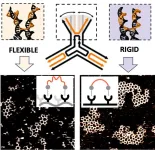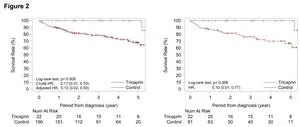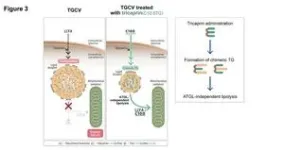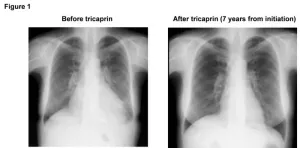(Press-News.org) Covalent bonding is a widely understood phenomenon that joins the atoms of a molecule by a shared electron pair. But in nature, patterns of molecules can also be connected through weaker, more dynamic forces that give rise to supramolecular networks. These can self-assemble from an initial molecular cluster, or crystal, and grow into large, stable architectures.
Supramolecular networks are essential for maintaining the structure and function of biological systems. For example, to ‘eat’, cells rely on hexagonal supramolecular networks that self-assemble from units of the three-armed protein clathrin. Clathrin networks form bubbles around nutrients to bring them into the cell. Similarly, a protein called TRIM5a forms a hexagonal lattice that forms around HIV viruses, helping to disrupt their replication.
“This hexagonal network structure is omnipresent in nature – you can even see it at the macroscale in beehives, for example,” explains Maartje Bastings, head of the Programmable Biomaterials Lab (PBL) in EPFL’s School of Engineering.
For their latest study published in Nature Chemistry, the researchers from the PBL and the Laboratory for Bio- and Nano-Instrumentation (LBNI), led by Georg Fantner, used nanoengineered DNA strands in a three-point star shape to isolate and examine the different factors controlling crystalline supramolecular network formation. In the process, they discovered a “defining parameter” even more important than chemical bond strength or number.
‘Interface flexibility will always win’
Like human DNA, the composition of the three-point star DNA molecules varied by their sequences of nucleotides, which affected their interaction strength (affinity) with neighboring molecules. But for this study, the researchers introduced an additional variable: through nuanced changes in the lengths of the strands making up each of the monomers’ three arms, they were able to modulate the arms’ local and global flexibility.
Using high-speed atomic force microscopy, the team observed that the DNA stars with shorter, rigid ‘arms’ organized into stable hexagonal networks, while those with longer, more flexible arms were unable to form any large networks. Simulations revealed that the short arms were nearly four times more likely to be arranged in a parallel shape more conducive to connecting with other molecules, while the longer arms tended to splay too far apart to create stable connections. The researchers termed this variation interface flexibility.
“The interface where two molecules come together must be rigid; if one is flexible, there’s a lower chance the molecules will stay connected. Binding strength isn’t important – interface flexibility will always win. This goes against what’s been understood to date,” Bastings says.
Interestingly, the researchers also showed that interface flexibility can be fine-tuned: in flexible molecules, they were able to restore local rigidity at the binding interface enough to support network growth, while maintaining the molecules’ overall larger size. “This means that even globally flexible monomers can still grow into networks if the interface flexibility at the point of binding is controlled,” Bastings summarizes.
Build or destroy
Bastings says this work could change how scientists design proteins and other molecules for self-assembly, and create new opportunities for cellular nanotherapies. Targeted approaches could focus on rigidity in the design of new supramolecular networks from proteins, for example; or on inducing flexibility for the strategic breakdown or prevention of undesirable networks, like amyloid plaques seen in relation with Alzheimer’s disease. She also foresees applications in spintronics, where the self-assembly of well-defined nanoscale networks could help build next-generation electronics.
She credits the achievement to the initiative of the students in her lab and collaborators from the LBNI. And she doesn’t forget to give due recognition to the humble DNA molecule.
“Advances in interdisciplinary DNA nanotechnology, and in the control of properties at the atomic level, have made it possible to take DNA out of the genomic context and transform it into a workhorse for discovering global physical interactions – like interface flexibility."
END
Scientists discover mechanism driving molecular network formation
EPFL scientists have identified a new property, interface flexibility, that controls how certain molecules naturally self-organize into crystalline supramolecular networks
2025-02-13
ELSE PRESS RELEASES FROM THIS DATE:
Comprehensive global study shows pesticides are major contributor to biodiversity crisis
2025-02-13
Pesticides are causing overwhelming negative effects on hundreds of species of microbes, fungi, plants, insects, fish, birds and mammals that they are not intended to harm – and globally their use is a major contributor to the biodiversity crisis.
That is the finding of the first study assessing the impacts of pesticides across all types of species in land and water habitats, carried out by an international research team that included the UK Centre for Ecology & Hydrology (UKCEH) and the University of Sussex.
Multiple negative impacts
The scientists analysed over 1,700 existing lab and field studies of the impacts of 471 different ...
A simple supplement improves survival in patients with a new type of heart disease
2025-02-13
Osaka, Japan – Heart transplant is a scary and serious surgery with high cost, but for patients with heart failure it can be the only option for cure. Now, however, a multi-institutional research team led by Osaka University has found that simply taking a supplement might be all that is needed for certain patients with heart failure to recover – no surgery needed.
In a study published in Nature Cardiovascular Research, the research team found that tricaprin, a natural supplement, can improve long-term survival and recovery from heart failure in patients with triglyceride deposit cardiomyovasculopathy ...
Uncovering novel transcriptional enhancers in neuronal development and neuropsychiatric disorders
2025-02-13
Neuropsychiatric disorders are becoming increasingly prevalent. Given their complex and multifactorial pathogenesis, there is an urgent need for effective and targeted therapies that can improve patients’ quality of life. Genome-wide association studies (GWASs) have identified various genetic alterations that contribute to the development and progression of neuropsychiatric disorders, ranging from mild dyslexia to more severe conditions such as schizophrenia.
While thousands of single nucleotide polymorphisms (SNPs)—changes in a single nucleotide position in the DNA—have been associated with neurological ...
IR Sant Pau study reveals immune system’s crucial role in ALS at cellular level
2025-02-13
A team of researchers from the Sant Pau Research Institute (IR Sant Pau) has published a study in the Journal of Neuroinflammation that, for the first time, examines in depth the role of the peripheral immune system in amyotrophic lateral sclerosis (ALS) at the single-cell level. Their findings suggest that immune system cells—particularly two subpopulations of Natural Killer (NK) cells—may play a crucial part in the development and progression of this neurodegenerative disease.
ALS is a condition that causes the progressive degeneration of motor neurones, leading to a loss of muscle function and, eventually, affecting ...
Brain rhythms can predict seizure risk of Alzheimer’s disease patients, study finds
2025-02-13
A UCLA Health research team has identified changes in brain rhythms that indicate seizure activity in Alzheimer’s patients.
The findings, published in Brain Communications, build on UCLA neurologist and senior author Dr. Keith Vossel’s pioneering work that first linked silent epileptic activity to cognitive decline in Alzheimer’s disease.
Vossel’s previous studies showed that silent seizures, detected through overnight electroencephalography (EEG) and one-hour magnetoencephalography (MEG), occur in more than 40% of Alzheimer’s patients—beyond the 20% who experience overt seizures. His research has demonstrated ...
Scientists develop innovative DNA hydrogels for sustained drug release
2025-02-13
Hydrogels are polymeric materials with three-dimensional network structures containing large amounts of water. They serve as sustained-release drug delivery systems as they can encapsulate various bioactive substances, including drugs, antigens, and even cells. Hydrogels are better drug delivery alternatives than conventional systems, as they are more biocompatible, biodegradable, and easily administered as an injectable scaffold.
DNA has gained significant attention as a promising hydrogel material thanks to its customizable physicochemical properties, leading to the development of various DNA ...
Paramedics facing challenging end-of-life care demands
2025-02-13
Paramedics in England are experiencing wide-ranging challenges in responding to the increasing number of end-of-life care patients they are being called out to, according to a study from the University of Southampton.
The study published in BMC Palliative Care highlights the issues paramedics face when responding to patients at end-of-life, including a lack of patient information, barriers to administering medication, and insufficient training.
It was funded by Marie Curie and supported by National Institute for Health and Care Research (NIHR) Applied ...
Worm study shows hyperactivated neurons cause aging-related behavioral decline
2025-02-13
A study of nematodes by researchers at Nagoya University in Japan has found that aging-related decline in brain function is caused by the excessive activation of certain neurons over time, rather than a decline in neuronal activity. This finding, published in the journal Proceedings of the National Academy of Sciences, suggests that interventions aimed at reducing neuronal hyperactivation, such as dietary changes, could potentially mitigate age-related cognitive decline.
Proper brain function occurs when a large number of neurons are connected to each other and work ...
Combining millions of years of evolution with tech wizardry: the cyborg cockroach
2025-02-13
Osaka, Japan – From disaster zones to extreme environments, there remain areas difficult for even humans to reliably access. This poses a problem for search-and-rescue operations, research, surveillance, and more. Now, however, a research team from Osaka University and Diponegoro University, Indonesia is hard at work on one potential solution: the cyborg insect.
Cyborg insects have a lot of advantages over traditional robots. Power consumption is less of an issue, so it’s easier to miniaturize them, and they are even ‘pre-built’ in a sense. However, research on cyborg insects has been limited to simple environments, like flat surfaces supplemented ...
Discrimination can arise from individual, random difference, study finds
2025-02-13
New research from the University of Sydney has found people tend to discriminate in favour of individuals who show a similarity to them, even when the similarity arises from a random event like the flip of a coin.
Published in Proceedings of the National Academy of Sciences, the research runs counter to traditional theories, in particular social identity theory, that assume discrimination occurs because we divide people into groups. It finds, instead, differences between individuals are enough to trigger discrimination.
Previous research (using the seminal ‘minimal group’ experiment) showed participants tend to financially benefit members of their own group over ...
LAST 30 PRESS RELEASES:
Study showcases resilience and rapid growth of “living rocks”
Naval Research Lab diver earns Office of Naval Research 2025 Sailor of the Year
New Mayo-led study establishes practical definition for rapidly progressive dementia
Fossil fuel industry’s “climate false solutions” reinforce its power and aggravate environmental injustice
Researchers reveal bias in a widely used measure of algorithm performance
Alcohol causes cancer. A study from IOCB Prague confirms damage to DNA and shows how cells defend against it
Hidden viruses in wastewater treatment may shape public health risks, study finds
Unlock the power of nature: how biomass can transform climate mitigation
Biochar reshapes hidden soil microbes that capture carbon dioxide in farmland
Reducing saturated fat intake shows mortality benefit, but only in high-risk individuals
Manta rays create mobile ecosystems, study finds
Study: Mixed results in using lipoic acid to treat progressive multiple sclerosis
Norbert Holtkamp appointed director of Fermi National Accelerator Laboratory
New agentic AI platform accelerates advanced optics design
Biologists discover neurons use physical signals — not electricity — to stabilize communication
Researchers discover that a hormone can access the brain by hitchhiking
University of Oklahoma researcher awarded funding to pursue AI-powered material design
Exploring how the visual system recovers following injury
Support for parents with infants at pediatric check-ups leads to better reading and math skills in elementary school
Kids’ behavioral health is a growing share of family health costs
Day & night: Cancer disrupts the brain’s natural rhythm
COVID-19 vaccination significantly reduces risk to pregnant women and baby
The role of vaccination in maternal and perinatal outcomes associated with COVID-19 in pregnancy
Mayo Clinic smartwatch system helps parents shorten and defuse children's severe tantrums early
Behavioral health spending spikes to 40% of all children’s health expenditures, nearly doubling in a decade
Digital cognitive behavioral treatment for generalized anxiety disorder
Expenditures for pediatric behavioral health care over time and estimated family financial burden
Air conditioning in nursing homes and mortality during extreme heat
The Alps to lose a record number of glaciers in the next decade
What makes a good proton conductor?
[Press-News.org] Scientists discover mechanism driving molecular network formationEPFL scientists have identified a new property, interface flexibility, that controls how certain molecules naturally self-organize into crystalline supramolecular networks









